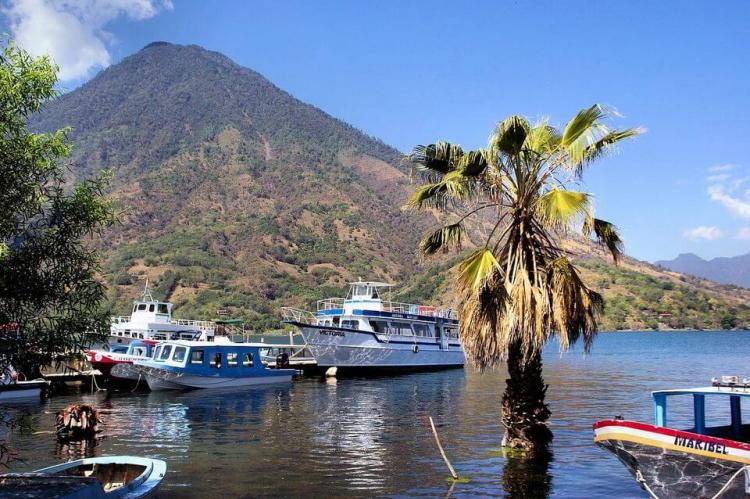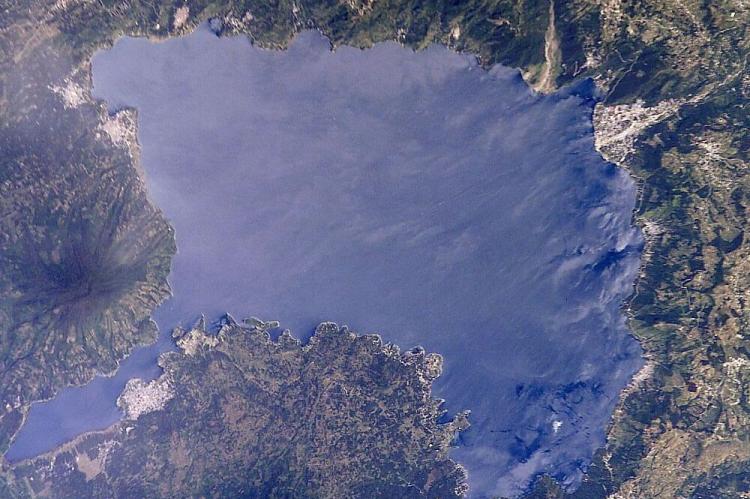Lake Atitlán: Volcán Atitlán (Guatemala)
Lake Atitlán and Volcán Atitlán lie in a spectacular setting in the Guatemalan Highlands of the Sierra Madre of southwestern Guatemala. The lake is the deepest in Central America and is renowned as one of the most beautiful in the world. As a result, it is the country's most important tourist attraction.
Lake Atitlán
Lake Atitlán lies in a spectacular setting in the Guatemalan Highlands of the Sierra Madre Mountain Range. It is located within the Sololá Department of southwestern Guatemala and is the deepest lake in Central America.
Lake Atitlán is renowned as one of the most beautiful lakes in the world and is Guatemala's most important national and international tourist attraction.
Occupying a valley dammed by volcanic ash, the lake sits approximately 1,563 m (5,128 ft) above sea level with a maximum depth of 320 m (1,049 ft) and is 19 km (12 mi) long and 10 km (6 mi) wide, with an area of 127.7 sq km (49.3 sq mi).
Atitlán is technically an endorheic lake, feeding into two nearby rivers rather than draining into the ocean. It is shaped by deep surrounding escarpments and three volcanoes on its southern flank. The lake basin is volcanic, filling an enormous caldera formed by an eruption 84,000 years ago.
The lake is bordered by three cone-shaped volcanoes: Atitlán, Tolimán, and San Pedro. The main towns along the lake, including Panajachel, Atitlán, and San Lucas, are popular with anthropologists and tourists.
Maya Culture
The Maya people influence the culture of the towns and villages surrounding the lake. As a result, the lake is surrounded by many villages in which Maya culture is still prevalent and traditional dress is worn.
The Maya people of Atitlán are predominantly Tz'utujil and Kaqchikel (or Cakchiquel) and comprise about 90% of the population in the surrounding area.
The area supports extensive coffee and avocado orchards and a variety of farm crops, most notably corn and onions. In addition, the lake itself is a significant food source for the largely indigenous population.
Several Mayan archeological sites have been found at the lake. Sambaj, located approximately 17 m (55 ft) below the current lake level, appears to be from at least the Preclassic Era.
Volcán Atitlán
Volcán Atitlán is a large, conical, active stratovolcano adjacent to the caldera of Lake Atitlán in the Guatemalan Highlands of the Sierra Madre de Chiapas range.
At approximately 3,537 m (11,604 ft), Volcán Atitlán is an active volcano with a complex history. It is part of the Atitlán volcanic complex, which includes several other volcanic cones.
The volcano has been active historically, with more than a dozen eruptions recorded between 1469 and 1853, which is its most recent eruption.
It is part of the Central America Volcanic Arc. The arc is a chain of volcanoes stretching along Central America formed by the subduction of the Cocos Plate underneath the Caribbean Plate. These volcanoes are part of the Ring of Fire around the Pacific Ocean.
Volcán Atitlán is a few miles south of Volcán Tolimán, which rises from the southern shore of Lake Atitlán. A long narrow bay separates Volcán Atitlán and Volcán Toliman from Volcán San Pedro.
Flora and Fauna
The cone-shaped volcano is characterized by steep slopes covered in lush vegetation, including forests and farmland. The surrounding region is known for its rich biodiversity, as the volcano's slopes provide diverse habitats for various plant and animal species.
The mountain is home to two scarce and beautiful birds that are endemic to the cloud forests of this region.
The horned guan (Oreophasis derbianus) is a Pleistocene relic of the family Cracidae that persists today only in small fragments of its previous range. Its habitat is limited to cloud forests above approximately 1,650 m (5,410 ft). This bird is the size of a turkey, and the adult male has a one-inch scarlet-colored "horn" projecting straight up from the top of its head.
The Cabanis or azure-rumped tanager (Tangara cabanisi) is probably the most restricted-range species in the region. It occurs only at mid-elevations within the Sierra Madre del Sur of Chiapas, Mexico, and western Guatemala.





